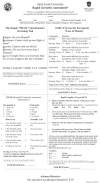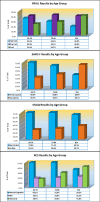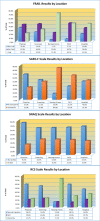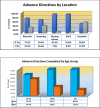High prevalence of geriatric syndromes in older adults
- PMID: 32502177
- PMCID: PMC7274399
- DOI: 10.1371/journal.pone.0233857
High prevalence of geriatric syndromes in older adults
Abstract
Introduction: The geriatric syndromes of frailty, sarcopenia, weight loss, and dementia are highly prevalent in elderly individuals across all care continuums. Despite their deleterious impact on quality of life, disability, and mortality in older adults, they are frequently under-recognized. At Saint Louis University, the Rapid Geriatric Assessment (RGA) was developed as a brief screening tool to identify these four geriatric syndromes.
Materials and methods: From 2015-2019, the RGA, comprised of the FRAIL, SARC-F, Simplified Nutritional Appetite Questionnaire (SNAQ), and Rapid Cognitive Screen (RCS) tools and a question on Advance Directives, was administered to 11,344 individuals ≥ 65 years of age across Missouri in community, office-based, hospital, Programs of All-Inclusive Care for the Elderly (PACE), and nursing home care settings. Standard statistical methods were used to calculate the prevalence of frailty, sarcopenia, weight loss, and dementia across the sample.
Results: Among the 11,344 individuals screened by the RGA, 41.0% and 30.4% met the screening criteria for pre-frailty and frailty respectively, 42.9% met the screening criteria for sarcopenia, 29.3% were anorectic and at risk for weight loss, and 28.1% screened positive for dementia. The prevalence of frailty, risk for weight loss, sarcopenia, and dementia increased with age and decreased when hospitalized patients and those in the PACE program or nursing home were excluded.
Conclusions: Using the RGA as a valid screening tool, the prevalence of one or more of the geriatric syndromes of frailty, sarcopenia, weight loss, and dementia in older adults across all care continuums is quite high. Management approaches exist for each of these syndromes that can improve outcomes. It is suggested that the brief RGA screening tool be administered to persons 65 and older yearly as part of the Medicare Annual Wellness Visit.
Conflict of interest statement
The authors have declared that no competing interests exist.
Figures





References
-
- Chong E, Ho E, Baldervarona-Llego, et al. Frailty in hospitalized older adults: comparing different frailty measures in predicting short-and long-term patient outcomes. J Am Geriatr Soc 2017. = 8;19(5):450–57.e3. - PubMed
Publication types
MeSH terms
LinkOut - more resources
Full Text Sources
Medical
Miscellaneous

